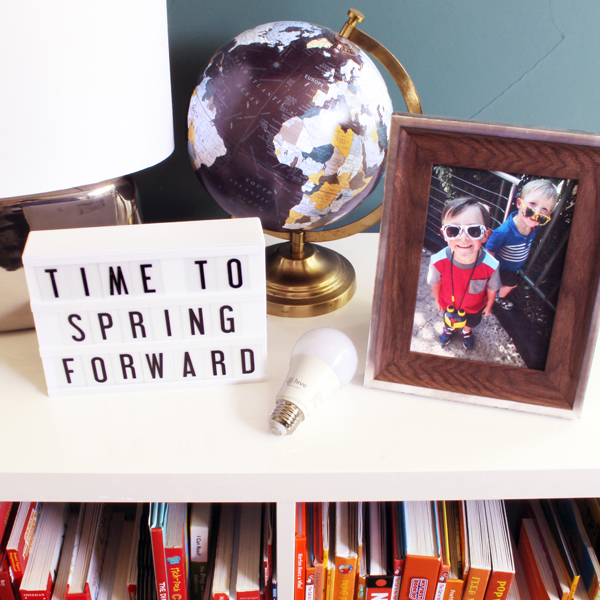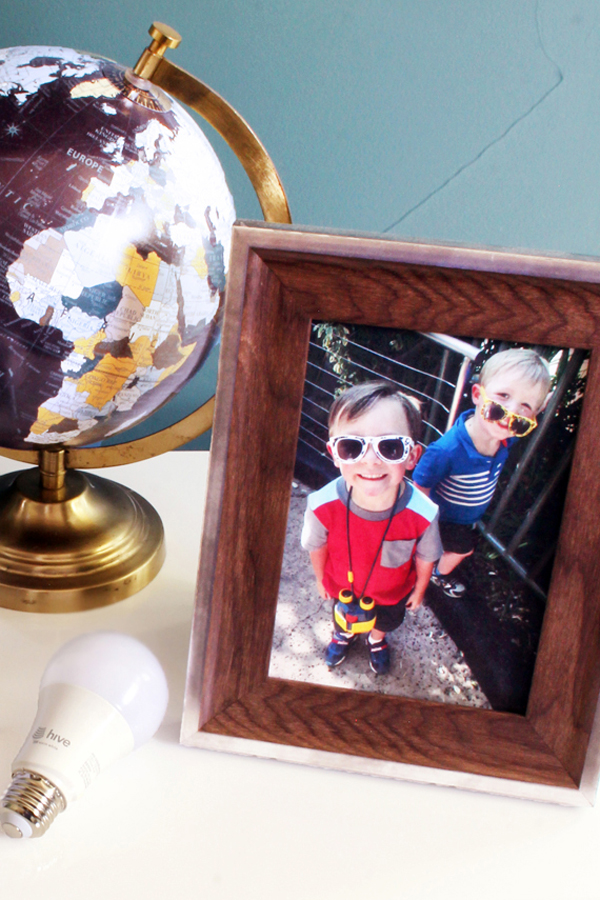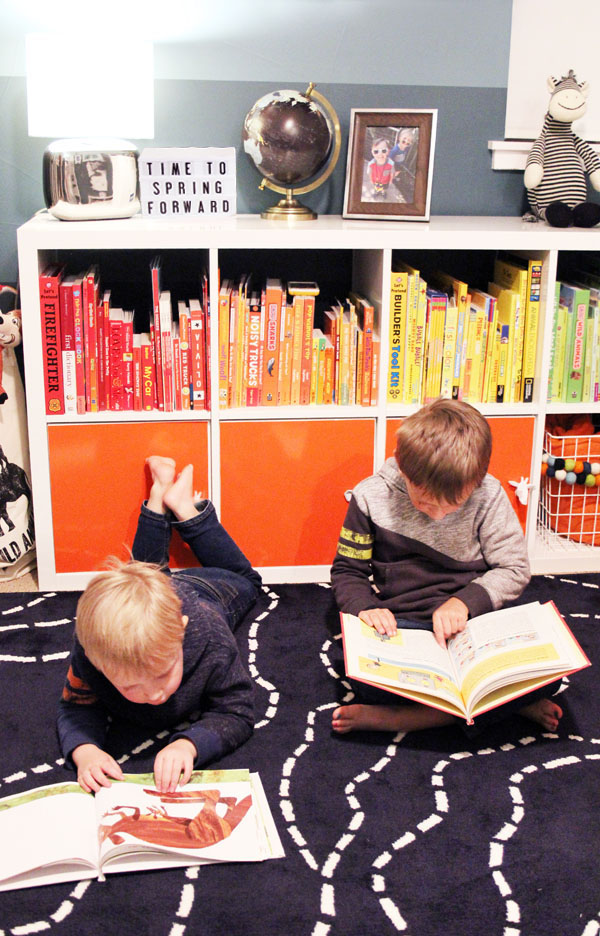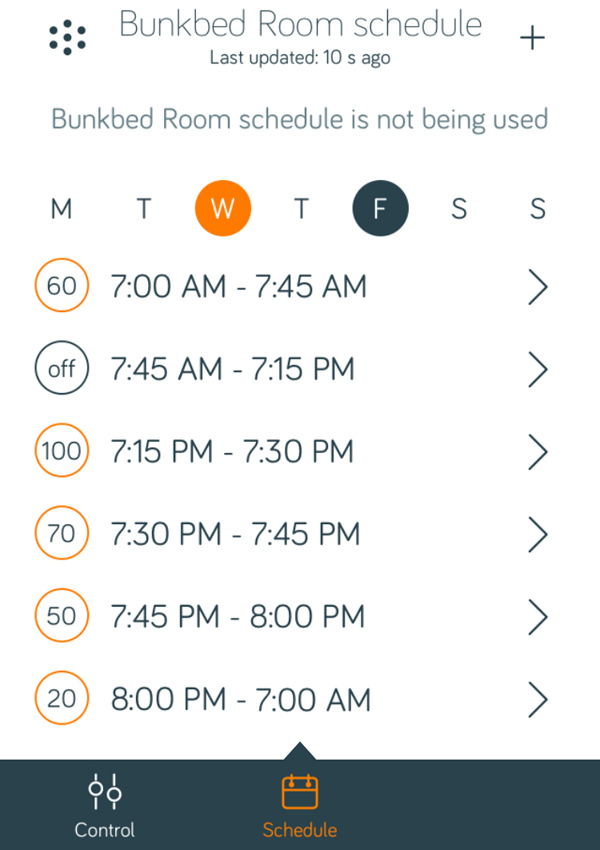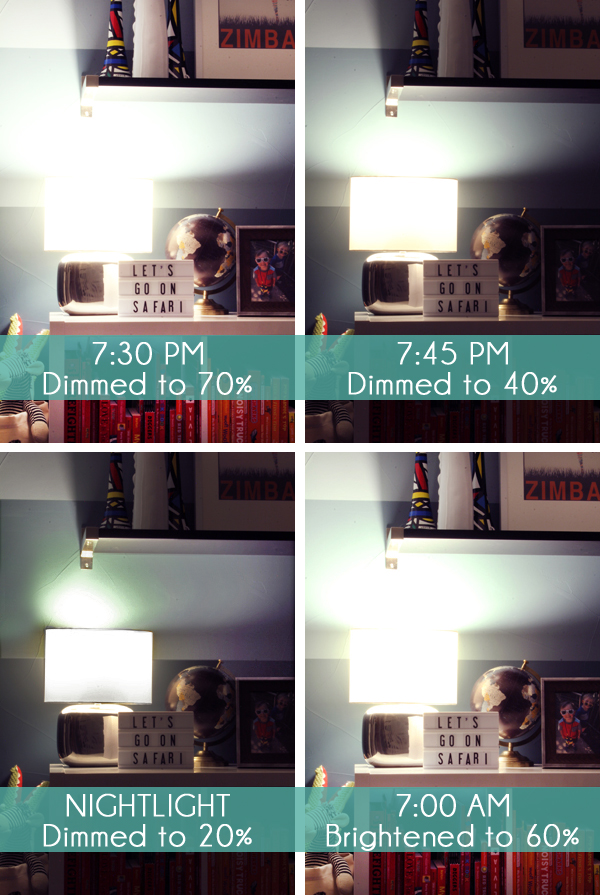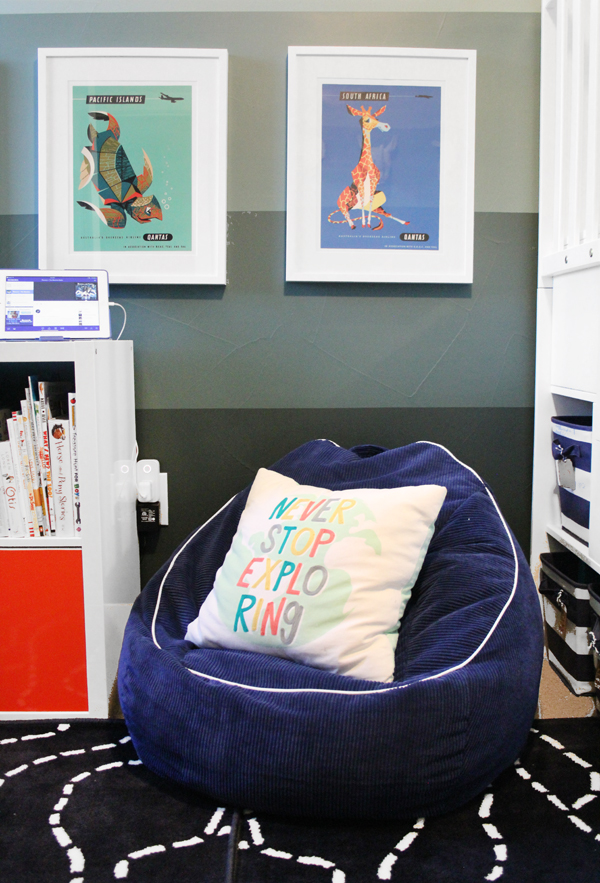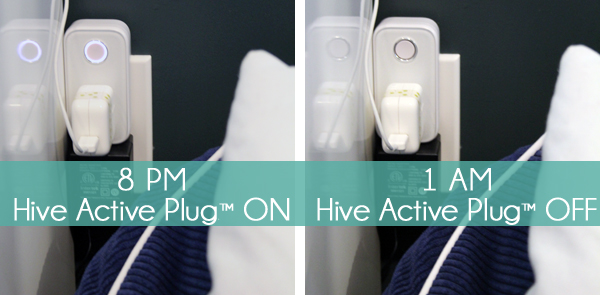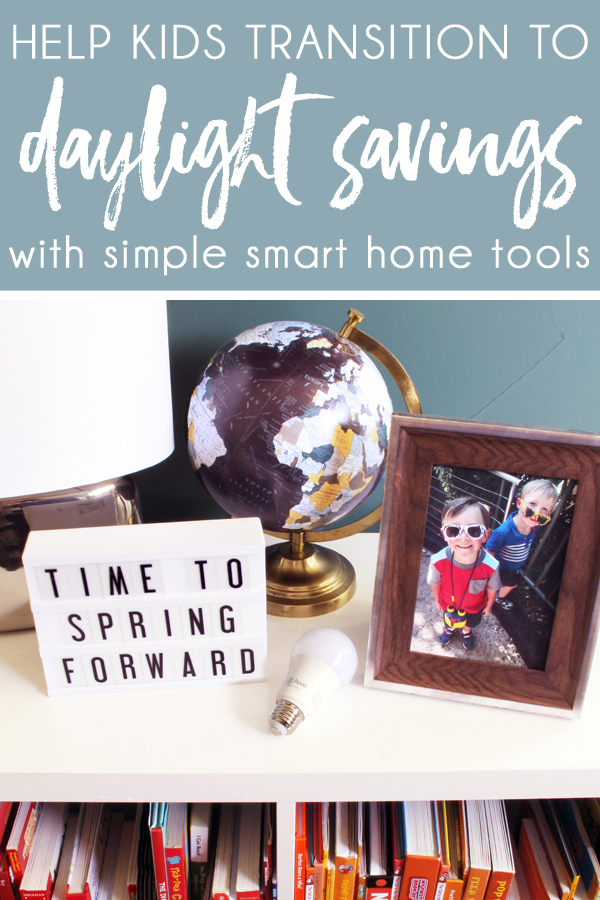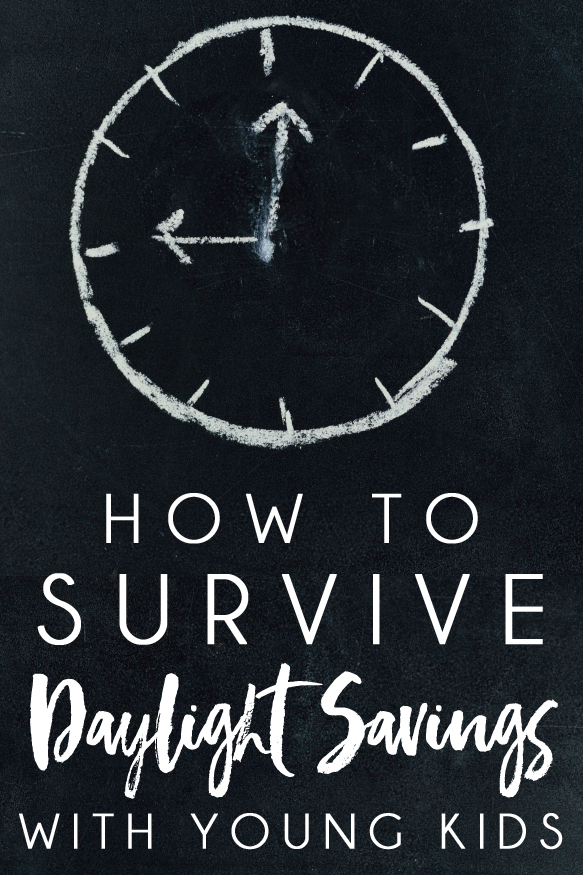var ts=document.getElementById(‘ti-pixel-tracker’); var axel = Math.random() + “”; var num = axel * 1000000000000000000; var ti=document.createElement(“img”); ti.style.display=”none”; ti.src=”http://tracking.tapinfluence.com/trk/IdWXh/0vYHl/p.png?p=Ud3Pf” + String.fromCharCode(38) + “i=tThdX” + String.fromCharCode(38) + “ord=”+ num + String.fromCharCode(38) + “s=” + encodeURIComponent(document.referrer); ts.parentNode.replaceChild(ti,ts); JSON.stringify({“program_id”:”cb938718-f0bd-11e7-9f9c-22000a7cc25a”,”post_id”:”7bc25918-1376-11e8-b578-02f5ba23ca96″});
CONTROL THE LIGHTS
Melatonin is the hormone that helps to regulate your body’s internal clock. As it gets dark in the evenings, melatonin increases and helps to induce sleep, and then it decreases when it becomes light outside again to incease wakefulness and alertness. Of course, when daylight savings kicks in each spring, and we start asking kids to go to bed when it’s still light out and often wake up before the sun, we are fighting against that natural cycle.
Make it Darker at Night. Closing the curtains or adding blackout shades helps to darken a child’s bedroom, but experts also recommend dimming the lights in a child’s room about 30-45 minutes before bedtime to help simulate the transition to nighttime and increase melatonin production.
If you’re a regular blog reader, then you know that we’ve been using Hive Active Light bulbs to set schedules and control lights all throughout our home for about a year now.
In the fall, when it was getting dark early, I set a schedule for the lamp in the boys’ bedroom to come on at the time they normally start getting ready for bed, so that they’d never have to go upstairs to a dark room. And, because our Hive smart home products integrate with Amazon Echo, I loved being able to ask Alexa to turn on the lights upstairs if the kids wanted to head up early to read or play before bedtime.
Now that we’ll be dealing with the opposite problem – getting the kids ready for bed when it’s still light outside – I’m setting a new schedule for the Hive Active Light bulb in the boys’ bedroom. I’m scheduling the lamp to come on 45 minutes before their 8 pm bedtime, and to gradually dim by 30% every 15 minutes. That way, it will gradually get darker in their room as we read books and go through the regular bedtime routine.
We typically leave their lamp on with the bulb dimmed to 30% all night as a nightlight, but I’m dropping that down to 20% for the coming weeks to make it just a little darker in their room, and hopefully help them to fall asleep a bit easier during the daylight savings transition period.
Using the Hive app on my phone, it’s so quick and easy to set exactly the schedule we want, and to make adjustments to it as needed. And I love that I can set a different schedule for the weekends when we typically let the boys stay up a little later.
Here’s the schedule I’ve created to automatically dim the Hive Active Light bulb in the boys’ bedroom for daylight savings:
Make it Lighter in the Morning. Dimming the lights as bedtime approaches is a great way to ease the transition at night, but we need a little help in the mornings as well.
One of my sons is a morning person, but the other… not so much! He’s a pretty happy kid if he wakes up naturally on his own, but if I have to wake him up, there’s a lot of crankiness and complaining to deal with. To make our mornings a little easier, I’ve also set the Hive Active Light bulb in their room to brighten from 20% to 60% at 7 am each morning. By gradually brightening the light in the room at the time he’s used to waking up, it will help keep the morning schedule the same and let him wake up naturally.
Adjust the Color Temperature of the Light to Match the Time of Day. While both sunset and sunrise naturally produce light in the warm color temperature range, which is shown to help us relax, research shows that cool light increases alertness and makes us feel more energetic. In addition to dimmable lights, Hive also offers Hive Active Lights that color change from cool to warm white.
These light bulbs allow you to set schedules to control the brightness as well as adjust the warmth of the light automatically, so you could set a schedule with warmer light at night to help the kids relax and get ready for bed, and then adjust it to a cooler light temperature in the morning to help kids feel more alert as they get ready for school.
ADD OTHER NATURAL CUES
Light is obviously one of the best natural cues for our kids to know when it’s time to sleep and when to wake up, but there are other cues that can help as well. Our boys used to fall asleep to white noise, but now prefer quiet music at night. Since they’ll need to start waking up when it’s still dark out, I’m going to also use music to help gently wake them in the mornings {because no kid wakes up happy to an alarm clock!}.
At night, we plug the boys iPad in to charge and turn on Pandora with a sleep timer set for 30 minutes. I’m also going to start setting an alarm for 7 am – but rather than an obnoxious sound, music will begin playing at the same soft volume they fell asleep to. The music, combined with the lamp in the room getting brighter, should help them wake up naturally.
Of course, it only takes a few hours for the iPad to fully charge, and then it’s plugged in the rest of the night for no reason. Since we are always looking for ways to save energy, I decided to add a Hive Active Plug and I’ve set a schedule so the plug is only on from 8 pm, when the boys go to bed, until 1 am, when the iPad will be fully charged.
In addition to saving money on the electric bill, setting Hive Active Plugs on a schedule is also a great way to prevent overcharging the battery on older devices with batteries that aren’t designed to stop taking charge once they are full.
A FEW MORE HELPFUL TIPS
- MAKE GRADUAL CHANGES IN ADVANCE: Doctors suggest that in the days leading up to the time change, you should gradually adjust bedtime. In the spring, when we lose an hour of sleep, you can start putting kids to bed about 15 minutes earlier each night, so that when the time change rolls around, you’ve adjusted them to going to bed an hour earlier to make up for the hour we lose. Then, on Sunday, when we move forward an hour, bedtime can return to its normal time.
- DON’T SKIP NAPS: If your kids still nap, don’t skip naptime in an effort to make them extra tired. Rather than making bedtime easier, this will likely make bedtime harder because overly tired kids get grumpy, and can then be harder to settle down to sleep.
- STICK TO YOUR ROUTINE: Kids get confused when the daily order of things changes, and the time change will likely make their naturally rhythms feel “off.” Help counteract this by keeping your bedtime routine consistent and doing everything in exactly the same order that you normally would. The fewer things that change, the easier the transition will be on your kids.
MORE WAYS TO MAKE PARENTING EASIER
This is a sponsored conversation written by me on behalf of Hive. The opinions and text are all mine. Comments submitted may be displayed on other websites owned by the sponsoring brand.
